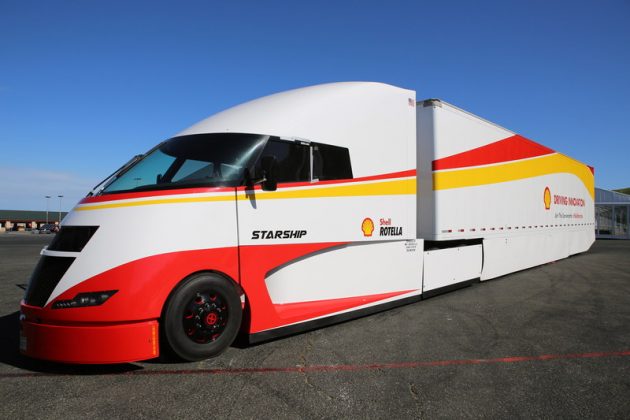
Meet Starship, Shell’s hyper-efficient transport truck
by Canadian Manufacturing.com Staff

The custom-built truck is a joint project between Shell Lubricants and AirFlow Truck Co. and uses currently available technologies to minimize the energy required to transport cargo

Shell Starship has arrived at Sonoma Raceway in California. PHOTO: PRNewsfoto/Shell
It uses currently available technologies to minimize the amount of energy it takes to transport a load of cargo from one point to another.
“We seek projects such as the Starship initiative to keep Shell at the leading edge of technology development and energy efficiency. Working with AirFlow Truck Company and other suppliers gives Shell Lubricants the opportunity to align with innovative companies to explore what is really possible in fuel efficiency,” says Robert Mainwaring, Technology Manager for Innovation, Shell Lubricants. “Transport accounts for more than one quarter of the world’s total energy use and one-fifth of global energy-related carbon dioxide emissions, 72 per cent of which is attributable to road transportation of which trucks make up a significant part. Increasing efficiency and fuel economy in the commercial transport sector could therefore make considerable progress to help reduce emissions.”
Shell provided technical consultation on engine and drivetrain components, as well as recommendations for lubricant needs for use in the Starship Project truck. The truck is using Shell’s next generation, low viscosity, fully synthetic heavy duty engine oil. The lower viscosity delivers superior fuel economy compared to a conventional SAE 15W-40. The lubrication technology shares the same viscosity as Shell Rimula Ultra E+ and is being tested by OEMs around the world.
“As the leader in heavy duty lubricants we have a responsibility to the industry beyond simply our products. Moving forward, we need creative solutions to the world’s energy challenge such as Starship that will benefit our customers, drivers and the wider world for years to come,” says Chris Guerrero, Global Brand Manager, Heavy Duty Lubricants.
In May 2018, Shell and AirFlow will demonstrate the performance of the Starship on a US coast-to-coast drive: beginning in California and ending in Florida. The truck will carry the maximum viable amount of freight within the allowed gross vehicle weight of 80,000lbs/36,287kgs.
The freight tonne efficiency and fuel economy will be measured along the way and the result will be shared publicly. Freight tonne efficiency is the primary indicator that will be measured on the Starship truck, defined as the energy required to move freight from point A to point B. Maximizing the amount of load the truck is carrying will decrease the fuel economy, however it will improve freight tonne efficiency and reduce weight specific carbon emissions.
To stay up-to-date on the latest Airflow Starship activities, visit www.shell.com/starship.
Starsip truck details
Starship is known as a Class 8 Truck in the US: this US specific-classification is determined based on the vehicle’s gross vehicle weight rating (GVWR). The classes range from 1–8 and are classified by the Department of Transportation’s Federal Highway Administration (FHWA).
The body of the Starship Project tractor is a custom-built, aerodynamic design made of carbon fibre. This includes the side skirts, hood, and front end.
The Starship Project truck is powered by a 6-cylinder engine with 400 horsepower and 1850-foot pounds of torque/2,508 newton metres. The standard engine has been calibrated with the transmission to run at very low speeds and down to 800 rpm.
Active grille shutters (active based on temperature to maximize aerodynamics and maximize efficiency) open to enable airflow through the radiator and into the engine compartment allowing cooling. When cooling is not needed the shutters are automatically closed, leaving the air to reroute around the vehicle. The result is less drag and reduced fuel consumption. Furthermore, closed shutters in cold-weather reduce warm up time of the engine.
The truck will, in the future, feature a hybrid electric axle system with an electric motor and axle replacing the rear tractor non-driven axle. This will provide a power boost while climbing grades, where most of the fuel is consumed, the axle transfers the energy out of the truck and feeds it into the battery for acceleration/braking. A downspeed axle configuration using advanced engine controls and automated manual transmission also provides improved efficiency combined with good pulling power.
A 5,000-watt solar array on the trailer roof charges and stores power in a 48- volt battery bank , and is sufficient to power the normal truck loads such as lights, wipers, blower motors, gauges, air conditioning and heating, microwaves, and other electrical components.